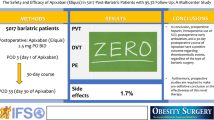Abstract
Purpose
To examine the surgical findings of ruptured abdominal aortic aneurysm (RAAA) based on the open-first strategy in the last decade, and to analyze the predictors of in-hospital mortality for RAAA in the endovascular era.
Methods
The subjects of this retrospective study were 116 patients who underwent RAAA repair, for whom sufficient data were available [25% female, median age 76 (70–85) years]. Sixteen (13.8%) patients were managed with endovascular aneurysm repair (EVAR) and 100 patients (86.2%) were managed with open surgical repair (OSR).
Results
Univariate analysis identified base excess (BE) (odds ratio [OR] 0.88; 95% confidence interval [CI] 0.79–0.96; p = 0.006), and preoperative cardiopulmonary arrest (CPA) [OR] 15.4; 95% [CI] 1.30–181; p = 0.030), BE (OR 0.88; 95% CI 0.79–0.96; p = 0.006), shock index (OR 2.44; 95% CI 1.01–5.94; p = 0.050), lactic acid (Lac) (OR 1.18; 95% CI 1.02–1.36; p = 0.026), and blood sugar (BS) > 215 (OR 3.46; 95% CI 1.10–10.9; p = 0.034) as positive predictors of hospital mortality.
Conclusions
The findings of this study suggest that a first-line strategy of OSR for ruptured AAAs is acceptable. Poor preoperative conditions, including a high shock index, CPA, low BE, high Lac, and a BS level > 215 mg/dl, were identified as predictors of hospital mortality, rather than the procedures themselves.

Similar content being viewed by others
References
IMPROVE Trial Investigators. Endovascular strategy or open repair for ruptured abdominal aortic aneurysm: one-year outcomes from the IMPROVE randomized trial. Eur Heart J. 2015;36:2061–9.
Reimerink JJ, Hoornweg LL, Vahl AC, Wisselink W, van den Broek TA, Legemate DA, et al. Amsterdam Acute Aneurysm Trial Collaborators. Endovascular repair versus open repair of ruptured abdominal aortic aneurysms: a multicenter randomized controlled trial. Ann Surg. 2013;258:248–56.
Desgranges P, Kobeiter H, Katsahian S, Bouffi M, Gouny P, Favre JP, et al. ECAR Investigators. Editorʼs Choice—ECAR (Endovasculaire ou Chirurgie dans les Anévrysmes aorto-iliaques Rompus): a French Randomized Controlled Trial of Endovascular Versus Open Surgical Repair of Ruptured Aorto-iliac Aneurysms. Eur J Vasc Endovasc Surg. 2015;50:303–10.
Mutschler M, Nienaber U, Münzberg M, Wölfl C, Schoechl H, Paffrath T, et al. The Shock Index revisited—a fast guide to transfusion requirement? A retrospective analysis on 21,853 patients derived from the TraumaRegister DGU. Crit Care. 2013;17:R172.
Seike Y, Yokawa K, Koizumi S, Masada K, Inoue Y, Matsuda H, et al. The blood sugar level can predict preoperative shock in patients with a ruptured abdominal aortic aneurysm even when the patient’s condition appears stable. Surg Today. 2022;52:595–602.
Koga Y, Mishima Y, Hara M, Hiraki T, Ushijima K. Prognostic factors associated with mortality in patients undergoing emergency surgery for abdominal aortic aneurysms. J Anesth. 2011;25:666–71.
The Japanese Society for Vascular Surgery Database Management Committee Member, NCD Vascular Surgery Data Analysis Team. Vascular Surgery in Japan. Annual Report by the Japanese Society for Vascular Surgery. Ann Vasc Dis. 2016;2021(14):419–38.
Mani K, Lees T, Beiles B, Jensen LP, Venermo M, Simo G, et al. Treatment of abdominal aortic aneurysm in nine countries 2005–2009: a vascunet report. Eur J Vasc Endovasc Surg. 2011;42:598–607.
Soden PA, Zettervall SL, Deery SE, Hughes K, Stoner MC, Goodney PP, et al. Society for Vascular Surgery Vascular Quality Initiative. Black patients present with more severe vascular disease and a greater burden of risk factors than white patients at time of major vascular intervention. J Vasc Surg. 2018;67:549–56.
Lemaire A, Cook C, Tackett S, Mendes DM, Shortell CK. The impact of race and insurance type on the outcome of endovascular abdominal aortic aneurysm (AAA) repair. J Vasc Surg. 2008;47:1172–80.
Williams TK, Schneider EB, Black JH 3rd, Lum YW, Freischlag JA, Perler BA, et al. Disparities in outcomes for Hispanic patients undergoing endovascular and open abdominal aortic aneurysm repair. Ann Vasc Surg. 2013;27:29–37.
Liang TW, Wang SK, Dimusto PD, McAninch CM, Acher CW, Timsina LR, et al. Association between body mass index and perioperative mortality after repair of ruptured abdominal aortic aneurysms. Vasc Endovascular Surg. 2020;54:573–8.
Miller MS, Kang M, Cornwall JC, Png CYM, Marin M, Faries P, et al. The impact of body mass index on perioperative and postoperative outcomes for endovascular abdominal aneurysm repair. Ann Vasc Surg. 2020;62:183–90.
The Japanese Society of Cardiology, The Japanese Society of Cardiovascular Surgery, The Japanese Society of Thoracic Surgery, The Japanese Society of Vascular Surgery. Guideline for Aortic Aneurysm and Dissection. https://www.j-circ.or.jp/cms/wpcontent/uploads/2020/07/JCS2020_Ogino.pdf. Japanese.
Mehta M. Technical tips for EVAR for ruptured AAA. Semin Vasc Surg. 2009;22:181–6.
Haveman JW, Karliczek A, Verhoeven EL, Tielliu IF, de Vos R, Zwaveling JH, et al. Results of streamlined regional ambulance transport and subsequent treatment of acute abdominal aortic aneurysms. Emerg Med J. 2006;23:807–10.
Dirks NPM, Mestrom M, van der Lugt M, van Osch F, Peters NALR, Elshof JM, et al. Utility of shock index for suspected rupture of abdominal aortic aneurysms. Prehosp Emerg Care. 2021;25:496–503.
Ouyang R, Ren H, Liu W, Yuan X, Lei E. Remifentanil inhibits the traumatic stress response in emergent trauma surgery. J Clin Lab Anal. 2019;33: e22971.
Altabas V, Altabas K, Berković-Cigrovski M, Malosevac S, Vrkljan M, Nikolić HV. Glucose metabolism disorders in patients with acute coronary syndromes. Acta Clin Croat. 2012;51:71–7.
Funding
This research did not receive any specific grant from funding agencies in the public, commercial, or not-for-profit sectors.
Author information
Authors and Affiliations
Corresponding author
Additional information
Publisher's Note
Springer Nature remains neutral with regard to jurisdictional claims in published maps and institutional affiliations.
Rights and permissions
Springer Nature or its licensor (e.g. a society or other partner) holds exclusive rights to this article under a publishing agreement with the author(s) or other rightsholder(s); author self-archiving of the accepted manuscript version of this article is solely governed by the terms of such publishing agreement and applicable law.
About this article
Cite this article
Seike, Y., Yokawa, K., Koizumi, S. et al. The open-first strategy is acceptable for ruptured abdominal aortic aneurysm even in the endovascular era. Surg Today 54, 138–144 (2024). https://doi.org/10.1007/s00595-023-02709-6
Received:
Accepted:
Published:
Issue Date:
DOI: https://doi.org/10.1007/s00595-023-02709-6




